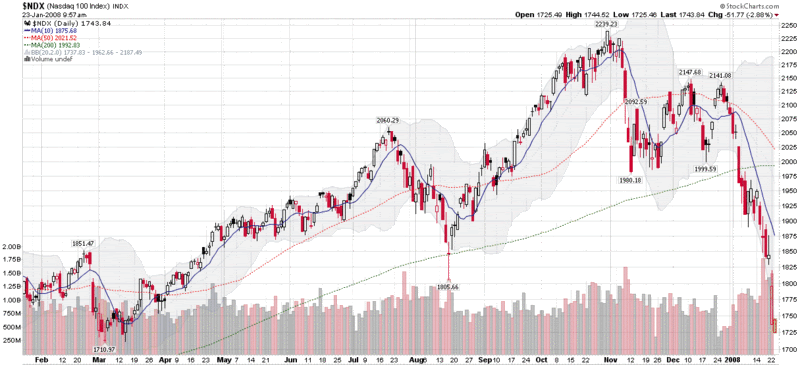NDX Fails Briefly, Other Indices Hold Bottoms
Bottoms are an interesting species. They are almost impossible to call in advance and surprisingly difficult to identify with a little hindsight. Typically, by the time you have enough hindsight to say, “Hey that was a bottom back there!” you have already missed a good portion of the move up from that point.
A number of indicators can help raise the probability of calling a bottom, the VIX among them, but we are still in the meteorological realm in terms of accuracy – and very much in the pre-Doppler era at that.
Most students of market bottoms agree that evidence of widespread capitulation is the best way to identify a market bottom. The reasoning is essentially that it is ‘better’ to have one day of extreme investor panic than a number of days in which the cumulative losses add up to one big drop while the psyche of the investor is able to digest the grief on the installment.
According to the reasoning above, yesterday had some elements of extreme investor panic at the open, but the ease with which the markets rallied from that point suggest that there may not have been enough panic or pain to account for a traditional capitulation bottom. This morning’s open was also relatively low in terms of panic and pain – at least on the capitulation scale – so there will be many who will wait for another strong retest of yesterday’s lows (and of investor fortitude) before committing to new bullish positions.
It is worth noting that one major index had yesterday’s low breached this morning: the NASDAQ-100 (NDX). Thanks to AAPL’s weak guidance yesterday after the bell, the stock opened dramatically lower and pulled the NDX down with it. The NDX has since recovered, but it and AAPL should be watched closely, as their support levels will likely be tested before those of the other more widely followed indices.



6 comments:
With NDX now trading 22 pts below yesterday's low, and thus the testing of yesterday's bottom, does it mean it is ready for a temporary rebound? Of course, it has yet to form the "death cross" perhaps the last one standing,and so does it mean it has more pain to endure?
Again, I appreicate your patience with my naive questions.
I wish there were easy answers, Adam, but there aren't. Instead, what we have is mostly probabilities -- and time frames. Better yet, think of different probabilities spread across a matrix of possible outcomes on another matrix of time frames.
Calling bottoms in advance is an expensive parlor game, for the most part. This pain could continue for another 10-20% down -- and trigger a bunch of 'oversold' signals on the way down.
At some point the marriage of fundamental data, technical analysiis and market sentiment indicators will lead to a bunch of conflicts, including the present situation.
I happen to think that there is a good probability that a bottom will form within the next week, but how long that bottom will hold and how much more pain will be involved even if that bottom holds are much harder questions to answer.
I continue to be mostly in watch and wait mode. You don't always have to have a bet down. Often it is better to let the market make up its mind before starting to play jellyfish.
Good trading,
-Bill
It's very early, but that test of NAS 2218 a moment ago appears to be holding, increasing the likelihood that this is a ST bottom.
Interesting Chart. Look at the top Bollinger Band. It hasn't even started coming down yet.
Time for everything to bounce, so we can all re-short. Charts for the Big Bounce bounce that's developing: (http://benbittrolff.blogspot.com/2008/01/charts-for-big-bounce.html)
TheFinancialNinja
Instead of trying to predict a bottom, and more often than not be wrong about it, it is usually better to wait for a clear trend to have established itself, before going long again.
Post a Comment